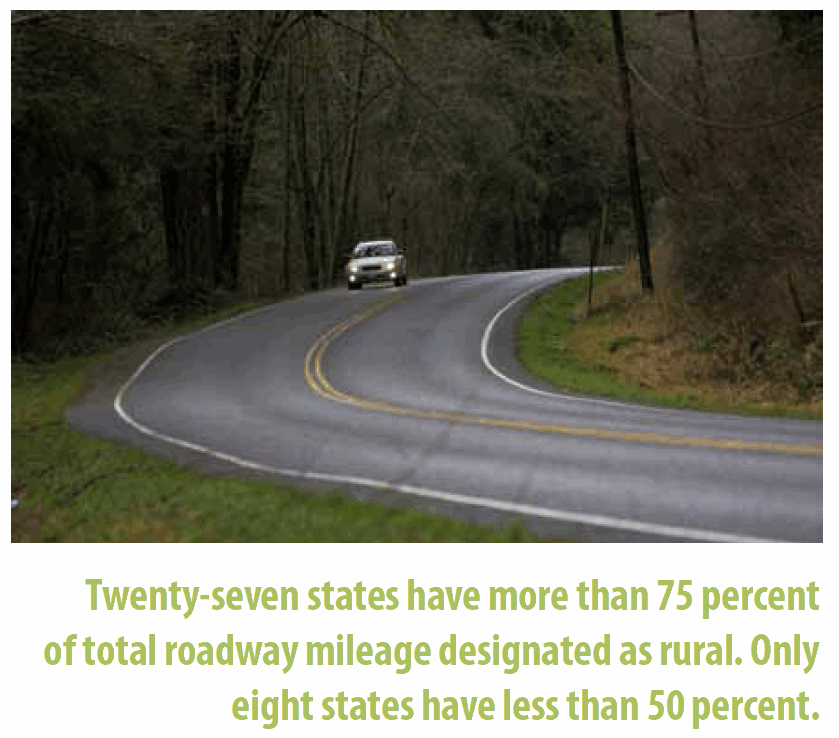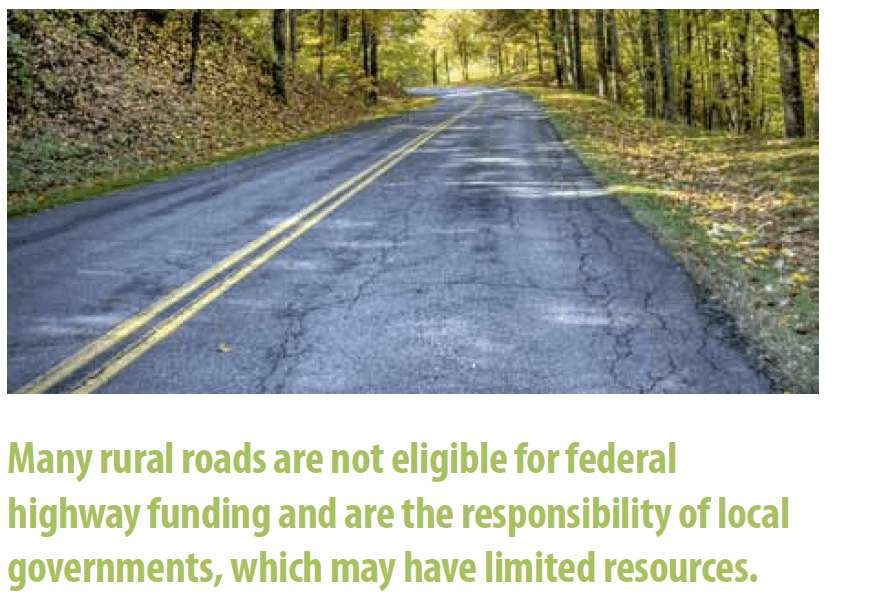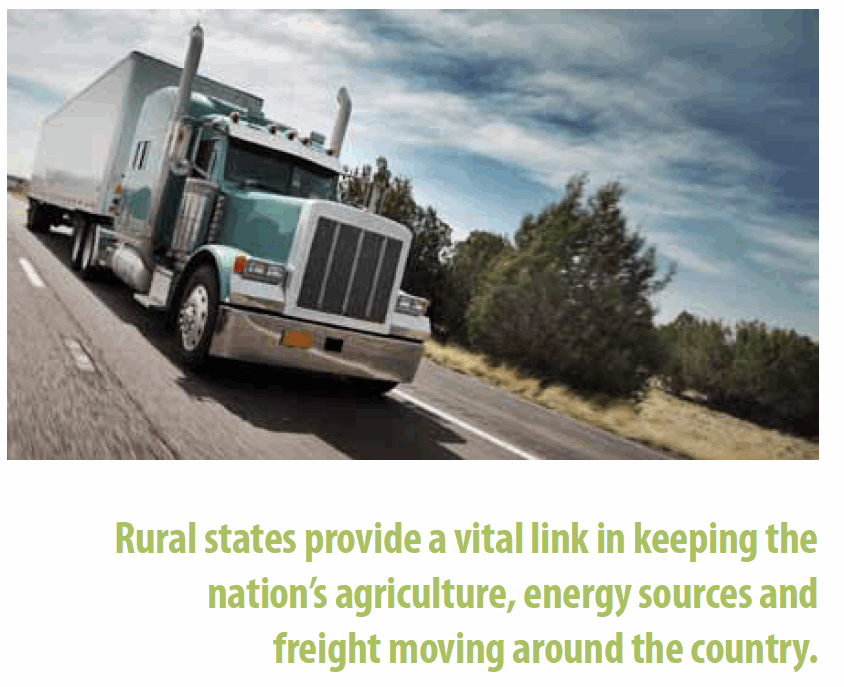THE COUNCIL OF STATE GOVERNMENTS
Executive Summary
Rural highways provide many benefits to the nation’s transportation system, including serving as a bridge to other states, supporting the agriculture and energy industries, connecting economically challenged citizens in remote locations to employers, enabling the movement of people and freight, and providing access to America’s tourist attractions.
Rural areas face a looming highway capacity crisis in the years ahead unless significant investments are made. But rural areas need substantially different kinds of investments, tools to finance rural transportation projects and policy strategies than urban areas need.
For many rural states, adequately funding roads and bridges is still the primary issue, much more than public transit, high speed rail and other transportation solutions that may make more sense in densely populated areas.
Rural areas face several transportation challenges, including inadequate roads, a lack of access to the interstate system and even traffic congestion. Most interstates were planned 60 years ago and little new capacity has been added since then to reach rural communities. Many rural two-lane roads cannot safely carry the heavy trucks and commercial vehicles used to transport freight.
According to the American Association of State Highway and Transportation Officials, commonly known as AASHTO, the nation’s roads need new capacity to improve connectivity and mobility for rural America; improve access for travel, recreation and tourism; enhance and expand rural transit opportunities; provide connections for new and emerging population and commerce centers; and ensure reliable access to defense installations. There are several areas where the transportation needs and solutions may be different for rural America and it’s important to contemplate those differences as changes to federal transportation policy are considered:
- Road Capacity Needs: A 2010 AASHTO report said the nation needs to add 30,000 lane-miles to the interstate system to meet rural needs.
- Congestion: Some rural transportation advocates fear that federal programs and funding targeted toward reducing traffic congestion may exclude rural communities by focusing on transit and high-speed rail. Congestion in rural areas is different from that in urban areas, but it is no less significant. It is often related to crashes, stalled vehicles, tourism or special events. Rural congestion can significantly impact freight movement, manufacturing processes, competitiveness and productivity. A federal authorization bill should address congestion in all parts of the country and on all modes of transportation.
- Livability: A federal focus on creating livable communities also has some rural advocates concerned it will mean more money for big city transit projects and less for rural roads. But others believe that suggests an outdated mindset that public transit is too costly and inefficient for rural areas, so roads should be the sole transportation focus for those communities. Rural livability may mean different things in different parts of the country, but rural communities provide the blueprint for what many say they want in their own communities, including walkable and accessible town centers.
- Road Safety: Road safety also must be a key focus of efforts to improve rural roads. Fifty-six percent of highway deaths occur on rural roads. Efforts to create better roads can range from low-cost ones like road signs to moderate-cost ones like median barriers to higher-cost improvements such as reducing the angle of dangerous curves. But because many rural roads are not eligible for federal highway funding, efforts to improve safety can fall to local governments that aren’t always equipped with either the necessary funding or the knowledge of road safety solutions. State governments will look to the next authorization for help in developing safety metrics that will allow them to pinpoint the areas where safety improvements are most needed. States and localities also can seek federal help in designing rural roads smarter with better engineering, appropriate speed limits, traffic calming measures such as roundabouts and intelligent transportation system technologies.
- Connectivity and Mobility: Rural states provide a vital link in keeping the agriculture, energy and freight industries moving around the country. But a lack of roads and rail, particularly in rural Western states, mean they don’t always move as quickly or efficiently as they could. According to AASHTO, additional arterial roads are needed to make easier and faster connections. Rural road improvements are needed to relieve freight bottlenecks. Also needed is more investment in freight projects to facilitate truck to rail transfers at grain elevators and other locations. Ports in major cities are not the only important links in the nation’s supply chain.
- Public Transit: According to AASHTO, federal funding for rural transit should more than double over the next six years. During that time, almost every transit vehicle (55,000 vehicles) in rural America will need to be replaced. Public transportation in rural communities may look a little different than it does in big cities, but it is no less important. The aging of the population in rural America has contributed to rising demand for transit. Rural transit often takes the form of on-demand service via small bus or van for non-emergency trips to the hospital, pharmacy or clinic, and trips to the grocery store. Due to the long distances and small numbers of people involved, rural transit can be an expensive proposition. Only 60 percent of rural counties nationwide have public transportation available and 28 percent of those have very limited service. Rural transportation advocates say they will seek flexibility from the federal government to use federal funding to pay for transit operating expenses. More coordination and cooperation is also needed among government agencies, community and faith-based groups, and private sector transportation providers to create a more seamless system of transit around the country.
- Funding Transportation: With the continuing erosion of the gas tax as the main revenue source to fund transportation improvements, some states and localities around the country are experimenting with alternative finance. But rural transportation advocates are concerned that some of the most commonly mentioned ones—tolling, congestion pricing, public-private partnerships and vehicle miles traveled charges—might not work for rural states and communities. Collection costs and the lack of traffic density in rural states make it unlikely that they would be able to raise significant funds from tolling unless tolls were set very high, in which case motorists would likely divert to other roads. For the same reasons, private companies would not be able to get a return on investment from funding toll road projects in these areas as part of public-private partnerships. Charging motorists a fee for each mile they travel —rather than each gallon of gas they buy— would also be problematic for rural states because of the long distances residents must often travel. From a new federal authorization bill, rural states will seek proportionate funding growth, increased funding, greater flexibility on the use of federal funds and more programs like Build America Bonds, which stand to benefit both urban and rural areas.


 Download full version (PDF): Rural Transportation Needs
Download full version (PDF): Rural Transportation Needs
About the Council of State Governments
www.csg.org
“The Council of State Governments is our nation’s only organization serving all three branches of state government. CSG is a region-based forum that fosters the exchange of insights and ideas to help state officials shape public policy. This offers unparalleled regional, national and international opportunities to network, develop leaders, collaborate and create problem-solving partnerships.”
Tags: Capitol Research, Council of State Governments, CSG, Rural






 RSS Feed
RSS Feed